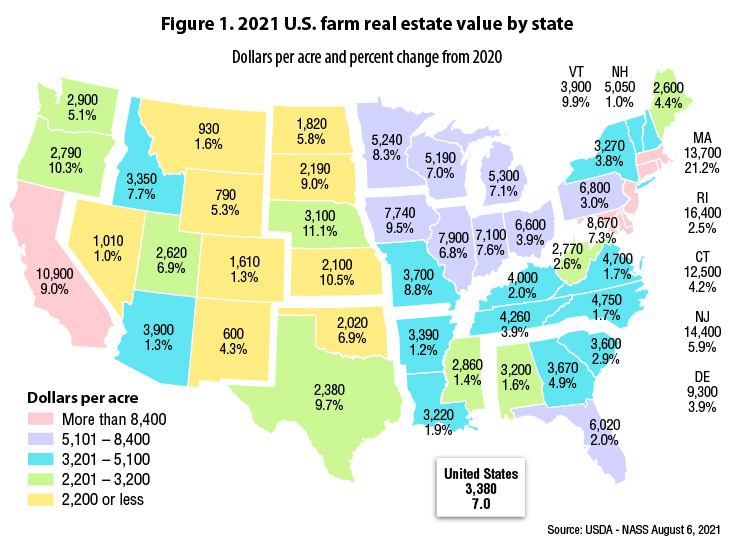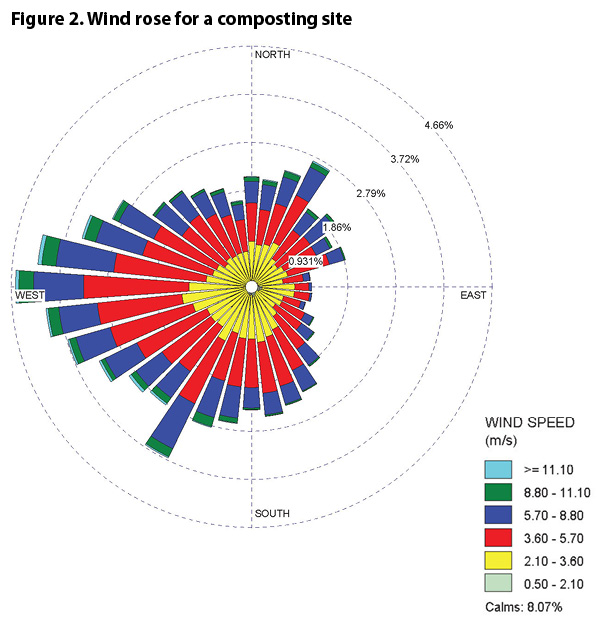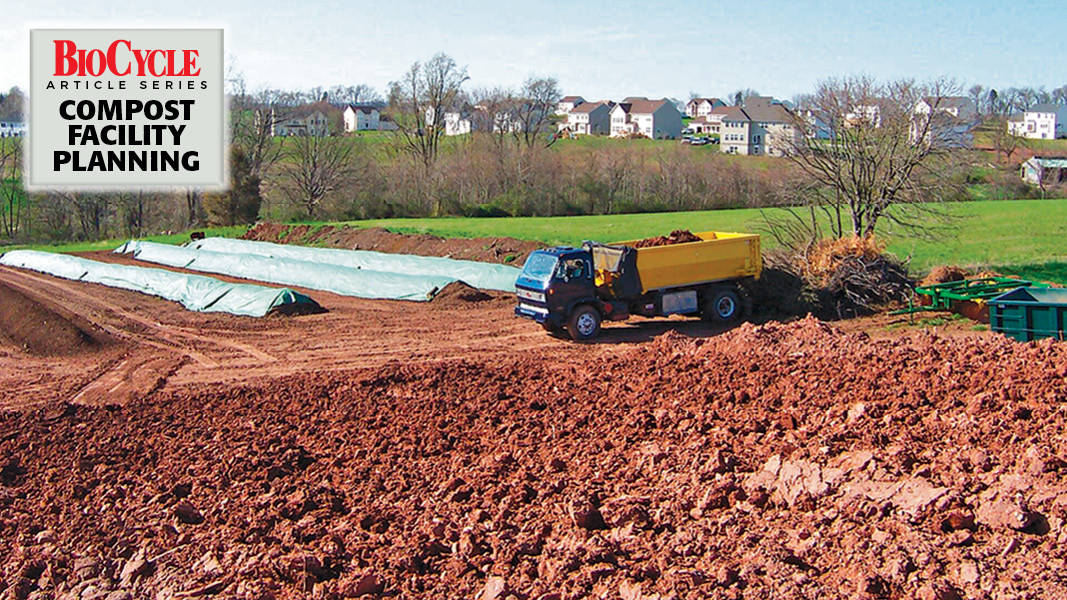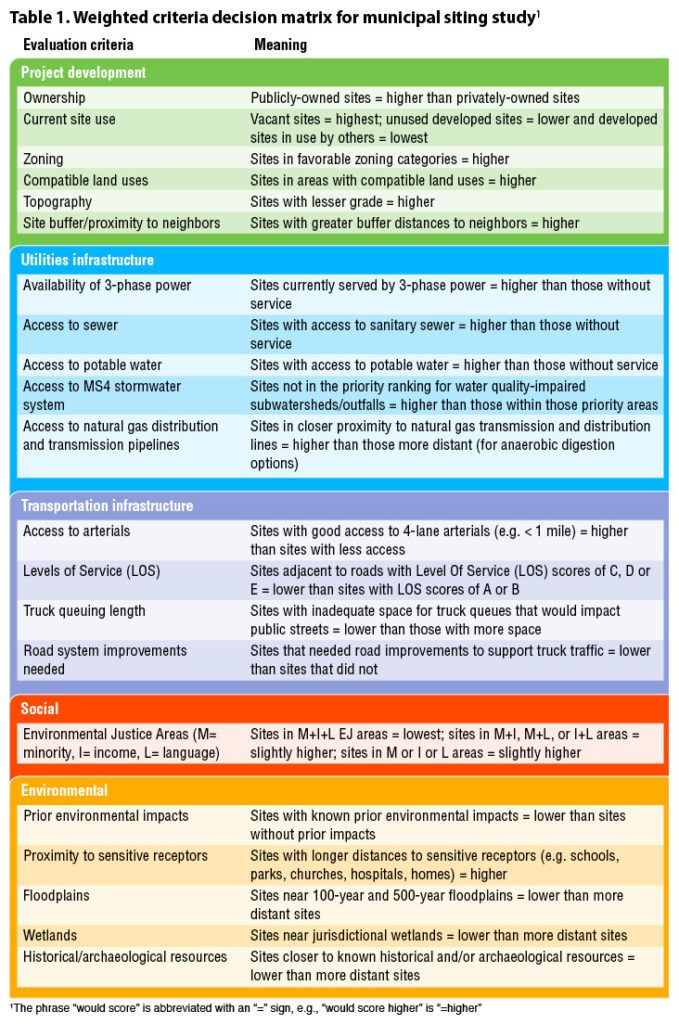Top: Two Particular Acres composting site circa 2004. Photo by George DeVault
Craig Coker
Fifth of a series of articles on issues to consider when planning a new composting facility in the U.S.
Planning a new merchant organics recycling facility requires considerable thought and investigation. As the old adage goes, “Proper prior planning prevents poor performance.” This facility planning series is oriented to helping you think through the aspects of proper prior planning. Part I dealt with how to develop a Waste Capture Plan. Part II covered methods to assess the markets’ potential to absorb your compost and/or soils products. Part III looked at how to figure out how much room you would need for your new composting facility. Part IV explored how to evaluate different composting approaches or methodologies. This article discusses issues to consider when looking at possible sites for a composting facility.
Finding the right site for a composting facility that is close enough to feedstock sources, product outlets, and adequate road networks — yet far from sensitive receptors — that will be approved by all levels of government authorities is perhaps the most difficult aspect of facility development…no, it actually is the most difficult aspect. You can spend a lot of time and money chasing sites. Using a methodical approach to siting can make it easier.
Some composters can find a site easily if they have access to land owned by family or friends. These types of sites usually require a compromise of sorts in terms of proximity, access, neighbors, or approvals, but the cost of leasing that land from Uncle Bob or your old college roommate will be less than the cost of purchasing. Remember, you will need a very long-term lease to justify the capital costs of the improvements you will be making. Leased land is not without risks; there have been several composting facilities shut down and forced to move off leased land when the landlord took issue with an operational malfunction like off-site odors or storm water runoff contamination.
For the purposes of this article, let us assume you don’t have access to family or friends’ land and will be looking for land to purchase for your new composting facility. At this point in your facility planning process, you should have finished your footprint analysis and sketched out how your facility might fit on a site with the most cost-efficient materials handling layout.
Where To Look, Factors To Consider
Most composters in search of land will look for farmland first, insofar as it is generally cheaper than suburban and urban land, is farther from sensitive receptors (usually), and can be easier to develop as the land is already cleared. The average price for farm real estate in the U.S. is $3,380/acre, with cropland averaging $4,420/acre and pasture land averaging $1,480/acre (USDA, 2021). The average cost of farmland has risen 68.2% over the past 15 years, and, not surprisingly, there are substantial variations from state to state, as shown in Figure 1.
 Needless to say, the cost of suburban or urban land is much higher. I am helping a client locate a site for their second composting facility in a largely agricultural area in Virginia with a university town as the county seat and an interstate highway bisecting the county. Land prices close enough to be within the sewer envelope are getting $35,000 to $50,000 per acre. As my client is looking for at least 20 acres for a 50,000 ton/year aerated static pile (ASP) composting facility, that means a land acquisition budget of $7,000,000+. If your business model is built around urban and suburban feedstock sources like commercial and residential food scraps, then looking for and renovating an older industrial building may be more cost-effective.
Needless to say, the cost of suburban or urban land is much higher. I am helping a client locate a site for their second composting facility in a largely agricultural area in Virginia with a university town as the county seat and an interstate highway bisecting the county. Land prices close enough to be within the sewer envelope are getting $35,000 to $50,000 per acre. As my client is looking for at least 20 acres for a 50,000 ton/year aerated static pile (ASP) composting facility, that means a land acquisition budget of $7,000,000+. If your business model is built around urban and suburban feedstock sources like commercial and residential food scraps, then looking for and renovating an older industrial building may be more cost-effective.
All sites have a prevailing wind direction and you should understand this before you buy land and use that knowledge to lay out your site. You can develop a “wind rose” for any land you are considering, using data from the National Centers for Environmental Information (NCEI) and freeware software called WRPLOT View from Lakes Environmental. You should get at least five years worth of hourly wind observation data from the nearest airport to your site of interest. Uploading the hourly wind direction and speed data into WRPLOT View will take some manipulation, as the NCEI spreadsheet data will have some empty cells where data is missing and the software will not accept a spreadsheet with missing data cells. An example of output from the model is shown in Figure 2. If your site is in more mountainous terrain, your wind rose may only be partially accurate, as mountain terrain makes the wind move around a lot more.
 The composting method you choose will have a very direct effect on the amount of land you will need. For example, consider a small facility handling 5,000 cubic yards (CY) per year. Using a tractor-pulled windrow turner will require about 78,000 square feet (SF) (1.8 acres) for the composting pad. Using a self-propelled straddle turner drops that footprint requirement to 32,600 SF, while using turned trapezoidal mass bed composting drops it further to 20,200 SF. Using an extended ASP configuration is the most space-saving of all, needing only 18,700 SF (USCC, 2014).
The composting method you choose will have a very direct effect on the amount of land you will need. For example, consider a small facility handling 5,000 cubic yards (CY) per year. Using a tractor-pulled windrow turner will require about 78,000 square feet (SF) (1.8 acres) for the composting pad. Using a self-propelled straddle turner drops that footprint requirement to 32,600 SF, while using turned trapezoidal mass bed composting drops it further to 20,200 SF. Using an extended ASP configuration is the most space-saving of all, needing only 18,700 SF (USCC, 2014).
Look for a site that has a consistent grade in one direction, and that grade, ideally, should be less than 4% to 6%. Sites with grades in two directions are said to have cross-slopes. Grading away one of the slopes is necessary for your composting pad to have efficient storm water runoff drainage with lesser potential for rainwater ponding (which is an odor source and a breeding ground for flies). Grading with a 100-hp bulldozer in Allentown, PA will cost you about $1,380/acre, so for the 1.8 acre composting pad in the above example, your construction costs will go up by $2,500. You could also use a gravel fill to negate one of the cross-slopes prior to an asphalt top layer, but again, that will add construction costs.
Remember to budget enough money and space for a densely vegetated buffer zone as people smell with their eyes. If they can see you, they will think what they are smelling is your facility, even if the cause is something else. A vegetated buffer zone is not just a row of small trees or vertically-oriented shrubs (think Leyland cypress) as it will take years for that to grow into a buffer. The buffer should be planted with an upper tree canopy and a lower shrub canopy for complete screening. A good buffer needs to be 30- to 50-feet deep, so it will take up a sizable footprint.
Site Evaluation Tools
Geographic Information Systems (GIS) modelling is very useful for doing larger-scale siting studies and online versions of GIS models are easy to use, e.g., ArcGIS. You can map a travel time radius from a site of interest to see if your feedstock sources or product distributors might be too distant to cost-effectively service given the quality of the road network. There are literally hundreds of downloadable GIS model geodatabases that cover environmental considerations (e.g., floodplains, wetlands, etc.), social issues like environmental justice areas, and some elements of infrastructure. (Note that locations of three-phase power, water mains and sewer lines are often not publicly available for security reasons.)
Remember also to study historical community growth patterns. Often these patterns follow roads, railroads or waterways linking two or more historically separate areas of population and industry. You may find the perfect site, but 15 to 20 years later you could be surrounded by development that intensifies awareness of your operation. My first project in composting, in 1977, was an Environmental Impact Statement on a proposed biosolids composting facility between Baltimore, MD and Washington, D.C. The selected site was not far from U.S. Route 29 and is shown in the left-hand photo in Figure 3. The right-hand photo shows that same area 30 years later.
If you have found more than one potential site in a favorable area, then a more formal evaluation/ranking system can be a helpful tool. I use a weighted-criteria decision matrix (WCDM) model, which was discussed in BioCycle a few years ago (Coker, 2016). The weighted criteria matrix is a decision-making tool to evaluate sites (in this context) based on specific criteria weighted by the importance of each criterion. Each site is scored against each evaluation criterion on a scale of 1 to 5, where 1 means the site did not meet the criterion well, 3 means it met it fairly well and 5 means the site met the criterion very well.
The score of each site against each evaluation criteria (known as the “raw score”) is then multiplied by the weighting factor for that criterion, then the scores are summed. The alternative with the highest weighted score is the suggested alternative. Table 1 shows a WCDM model for a municipal siting study we are currently working on in Boston, MA.
Taking the time to carefully look for a good site is well worth it. This is going to be a long marriage so you want it to be the right one.
Craig Coker is CEO of Coker Composting & Consulting near Roanoke VA and is a Senior Editor at BioCycle CONNECT. He can be reached at ccoker@cokercompost.com.














